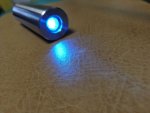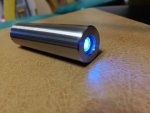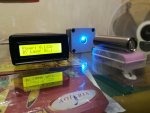- Joined
- Dec 12, 2012
- Messages
- 854
- Points
- 63
So I just fired up my 473nm diode I got from Zach.
At threshold it was at around 473nm-474nm. When I did my wavelength measurements I forgot to heatsink the diode module.
But I notice something interesting, at 100mA the spectrum split into two peaks, one at 475nm and another at 477nm, with 477nm being only 8% less intense. At 230mA the wavelengths were 476nm and 478nm, with about the same ratio.
I am very sure that this two wavelength effect is mostly result of temperature, because after I realized that the module was getting too hot I let it cool off and then measured the wavelength quickly at 230mA and the spectrum was a single wavelength at around 475nm. I estimate that the module reached a temperature between 100 F to 130 F. I suspect that a large cause of the diodes wavelength shift is only related to the temperature. I guess that could be tested to see for sure by keeping the diode current the same while changing the ambient temperature.
Luckily the diode seams to have survived just fine.
Have any of you guys that have spectro'd these diode noticed anything like this?
At threshold it was at around 473nm-474nm. When I did my wavelength measurements I forgot to heatsink the diode module.
But I notice something interesting, at 100mA the spectrum split into two peaks, one at 475nm and another at 477nm, with 477nm being only 8% less intense. At 230mA the wavelengths were 476nm and 478nm, with about the same ratio.
I am very sure that this two wavelength effect is mostly result of temperature, because after I realized that the module was getting too hot I let it cool off and then measured the wavelength quickly at 230mA and the spectrum was a single wavelength at around 475nm. I estimate that the module reached a temperature between 100 F to 130 F. I suspect that a large cause of the diodes wavelength shift is only related to the temperature. I guess that could be tested to see for sure by keeping the diode current the same while changing the ambient temperature.
Luckily the diode seams to have survived just fine.
Have any of you guys that have spectro'd these diode noticed anything like this?
Last edited:










